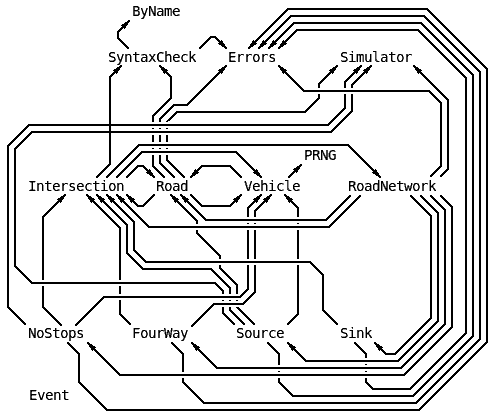|_
_|
|
|-
|_
=|
There are numerous forms of output (they are all listed in the assignment for the machine problem). You could select the form of output using a long cascade of if statements such as: If the output used to be false and it is now true and it changed just once, use the string " |_ ".
A Question: Give a simple algorithm that picks the correct string out of an array of strings using just the current value of this output and the number of changes to this output since the last time it was printed. Note that the previous value of the output need not be tested if the number of output changes is known. (1 point).
Suppose the new (current) value of the output is false:
| Changes | Character |
|---|---|
| 0 | " | " |
| 1 | " _| " |
| 2 | " |- " |
| 3 | " ,=' " |
| 4 | " |= " |
| odd>3 | " ,=' " |
| even>4 | " |= " |
For even values, we just use the mirror image of the string. So we will use an array of 5 strings, trueArray (or two arrays of 5 strings, trueArray and falseArray where trueArray[i] is the reverse of falseArray[i]). The code to output the right string could look like this:
if (changes > 4) changes = 4 - (changes & 1);
if (current) {
System.out.append( trueArray[ changes ] );
} else {
System.out.append( falseArray[ changes ] );
}
- Road.enter() schedules both Road.exit()
and Intersection.enter() to happen at the same time.
- Road.enter() schedules just Road.exit(),
and then when Road.exit() is triggered, it
schedules Intersection.enter() to happen immediately.
- Road.enter() schedules just Road.exit(), and then when Road.exit() is triggered, it directly calls Intersection.enter().
Suppose we add this code to the very end of Road.exit():
System.out.println( "Exiting " + this.toString()
+ " at time = " + t
);
And we add this code to Intersection.enter():
System.out.println( "Entering " + this.toString()
+ " at time = " + t
);
A Question: One of the 3 approaches used above guarantees that the exit message will be printed before the enter message. One of the three approaches guarantees that the enter message will be printed before the exit message, and one offers no guarantees because it depends on decisions made elsewhere in the simulator that would be correct in a formal sense for either order. Which of the three leads to which order guarantee? (1.0 points)
Having Road.exit() schedule Intersection.enter() guarantees that the exit message will print before the enter message.
If Road.enter() schedules both Road.exit() and Intersection.enter(), the order depends on how the event scheduler breaks ties. This is outside our control.
Note: Legibility matters! We strongly suggest that you draw it once just to get the details right, and then redraw your diagram to look nice, with some kind of ordelry arrangement where classes that depend on none of the other classes in this project on top, classes that are codependent in the middle, and classes that depend on them at the bottom. (1.0 points)
First, here are all the classes:
Simulator ByName Errors SyntaxCheck Road Intersection NoStops FourWay Source Sink PRNG Vehicle Event RoadNetwork
Second, here are the "depends on" relations:
Simulator ->
ByName ->
Errors ->
SyntaxCheck -> ByName Errors
Road -> Intersection Errors
SyntaxCheck (byName)
Vehicle Simulator
Intersection -> Road RoadNetwork
SyntaxCheck (byName)
Vehicle
NoStops -> Intersection Vehicle
Errors Simulator
FourWay -> Intersection Vehicle
Errors
Source -> Intersection Simulator
Vehicle Road
Errors
Sink -> Intersection Errors
PRNG ->
Vehicle -> Road PRNG
Event ->
RoadNetwork -> Intersection Road
NoStops FourWay
Source Sink
Errors Simulator
With this worked out, we can now try to draw a nice figure.

This figure is a tangled enough snarl to raise doubts about the utility of this kind of graphic notation. It is clear that the dependency relationships between the different classes in the program should be documented, but despite the saying, a picture is not always worth a thousand words. The lists of dependencies given in textual form above seem more useful than the diagram.